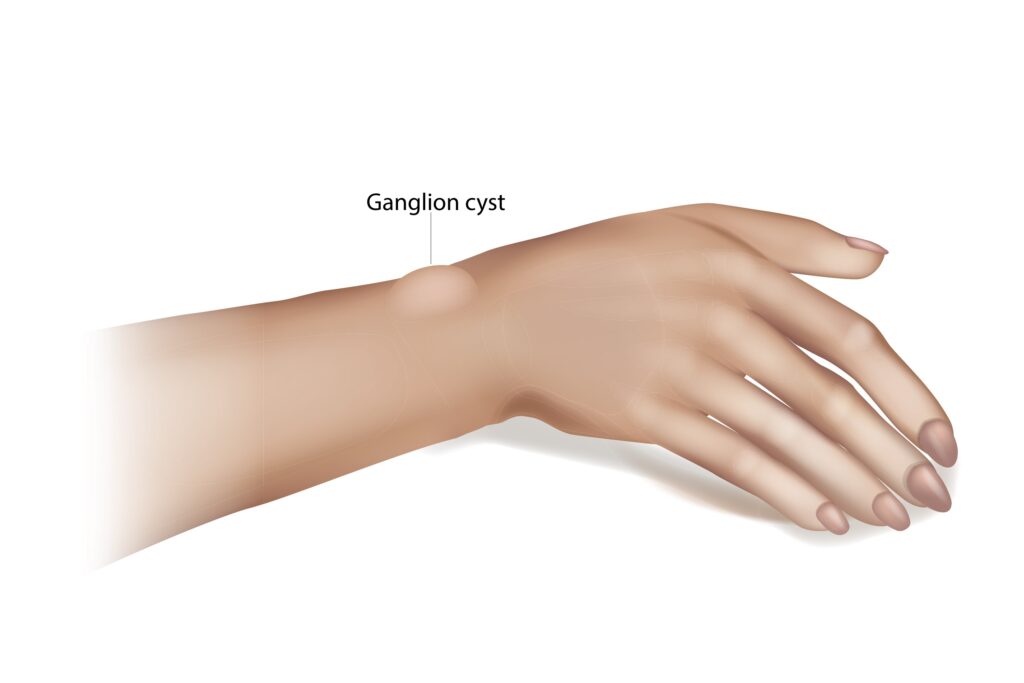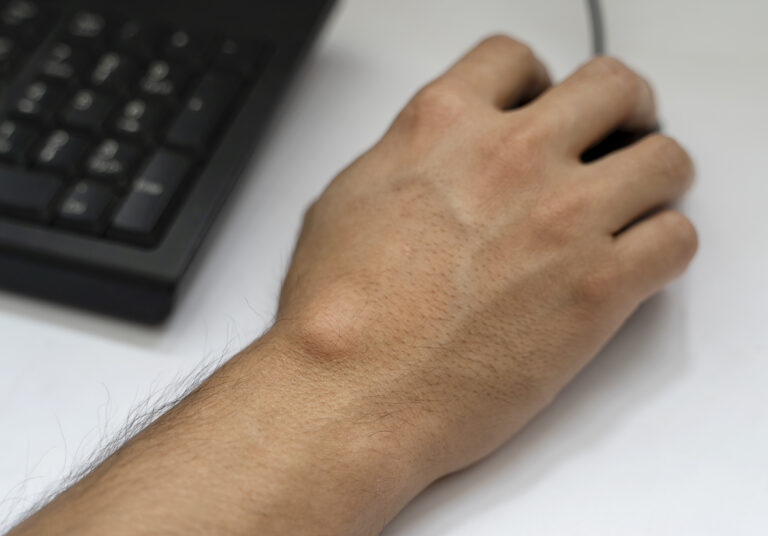In most cases, ganglion cysts usually go away on their own. However, if you are experiencing any symptoms, your doctor may suggest draining the cysts or surgically removing them. Here’s everything you need to know.
Ganglion Cyst Surgery Overview
- Surgery Time: 30 minutes or under
- Anaesthetic: Local
- Hospital Stay: Same-day
- Dressing and Garments: Dressing and plaster splint for 5 days
- Time Off Work: up to 2 weeks
- Exercise: 2-4 weeks
- Mobile: Same day
- Washing: Following day
- Sleeping Position: Keep hand elevated for 2-3 days, propped up on a pillow
- Full Recovery: 2-6 weeks
What are Ganglion Cysts?
Ganglion cysts are noncancerous lumps that develop in the joints and tendons of your hands or wrists, although they can also occur in the feet and ankles. The cysts are usually pea-sized, but larger ones can be around an inch in diameter and filled with a jelly-like fluid.
So, do ganglion cysts hurt? The cysts can be very painful, especially if they press against a nerve. You might also find it hard moving a certain joint depending on where the cyst is. There are different types of ganglion cysts, including:
- Dorsal wrist ganglion cyst: This type of ganglion cyst occurs in teenagers and young adults. The cysts usually last for about 2 years before disappearing on their own. If not, draining the fluid can help, although there is a high chance that the cyst will return.
- Palmar wrist ganglion cyst: These cysts occur primarily in young adults and older individuals with wrist arthritis. Surgery and fluid drainage are sometimes recommended.
- Dorsal digital ganglion cyst: This type is common in middle-aged and older people. It is usually associated with early osteoarthritis. Pressure from the cyst usually causes a ridge or furrow in the fingernail; occasionally, some fluid may leak through the skin. Even after surgery, there is a 10% chance that the cyst will recur. You may also develop other problems like joint stiffness, pain, and infection.
- Flexor tendon sheath ganglion cyst: This kind occurs in young adults and causes pain when one is holding with something. Puncturing the cysts will disperse it, and rarely do they recur.

What Causes Ganglion Cysts?
The exact ganglion cysts cause or what causes the cysts to begin growing in the first place is unknown. Some theories suggest that the cysts develop after an injury to the joint, forcing the underlying tissue to bulge or leak out.
However, it’s thought that the cysts develop from mesenchymal cells found in the synovial capsular junction due to continuous micro-injuries. Repetitive injury to the supporting ligamentous and capsular structures stimulates the production of hyaluronic acid, which accumulates in the area to form the jelly-like substance that makes up ganglion cysts.
Factors like gender, age, and arthritis may increase your risk of developing ganglion cysts. For instance, women and those in early to mid-adulthood are more likely to develop ganglion cysts.
What are the Symptoms of Ganglion Cysts?
Some of the symptoms to look out for include:
- A soft mass or bump that doesn’t move but changes size
- Swelling that may appear suddenly or over time
- Pain after repetitive or acute trauma
- Pain that gets worse with joint movement
- Weakness in one or two fingers

What Does Ganglion Cyst Treatment Involve?
Ganglion cysts can occur in multiple places. For example, you can have ganglion cysts on fingers or on wrists. Treatment involves surgical and non-surgical options like observation, immobilisation and aspiration.
If you don’t have any pain symptoms, your doctor may suggest you wait and watch if any changes occur. This is the safest option since ganglion cysts are noncancerous and usually disappear on their own after some time.
With immobilisation, a wrist brace or splint is used to relieve symptoms and cause the cyst to decrease in size. Usually, an activity often leads to the cysts increasing in size, which puts pressure on the nerves resulting in pain. As the pain continues to subside, your doctor may recommend certain wrist exercises to improve your motion range.
If that doesn’t work, aspiration is recommended where the fluid in the cyst is drained. The doctor numbs the area around the cysts before puncturing them with a needle. Your doctor will then drain the fluid.
If non-surgical treatments don’t work, your doctor may recommend surgery or if the ganglion returns after aspiration. During surgery, the doctor removes the entire cyst, including the tendon sheath or joint capsule. However, there’s still a tiny chance that the cyst will return. The surgery is done on an outpatient basis, and most patients get to go home the same day.
You may experience some swelling, discomfort and tenderness on the surgical site. After the surgery, you can resume normal activities after 2 to 6 weeks. How much time you take off work depends on the type of job you do. If you work in manual labour, you may need to take a couple of weeks off as you heal.
Having a ganglion cyst removed is a minor procedure, and complications are rare. Potential risks and complications of ganglion cyst surgery include:
- Infection
- Bruising
- Swelling
- Anaesthetic complications if under general anaesthetic
- Permenent stiffness and pain after surgery
Can Ganglion Cysts Be Cancerous?
No, ganglion cysts are usually noncancerous. While they may appear as lumps, the cysts are not cancerous and neither can they be cancerous. They behave like benign tumours except that they are asymptomatic. Patients may experience tenderness, pain, and decreased muscle tone, among other symptoms. But unlike benign tumours, ganglion cysts can’t progress to become malignant.
How Long Do Ganglion Cysts Last?
Or do ganglion cysts go away? In reality, most ganglion cysts go away without any treatment. At the same time, some recur even after treatment. If you develop a cyst, it can take 12 to 18 months to disappear. If the cyst causes symptoms that begin to affect your quality of life, your doctor will discuss with you the best treatment plan.
To book a consultation today, please call 0203 582 4947 or email [email protected].
Further Reading:
- What’s the Difference Between Trigger Finger vs Dupuytren’s Contracture?
- How to Release a Stuck Trigger Finger
- What are Two Conditions that are Often Misdiagnosed as Carpal Tunnel Syndrome?
- How Long Do Ganglion Cysts Last?
- What Does a Ganglion Cyst Look Like?
- Carpal Tunnel Syndrome Exercises After Surgery: What to Expect
- How to Sleep with Carpal Tunnel Syndrome
- 5 Common Types of Hand Surgery
- How To Get Rid of a Ganglion Cyst
- Plastic Surgery Statistics
- What is the Best Ganglion Cyst Treatment?
- What Causes Ganglion Cysts?
- What Happens During Ganglion Cyst Wrist Surgery?
- Is a Ganglion Cyst Painful?










